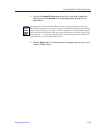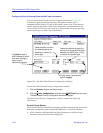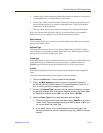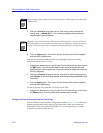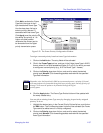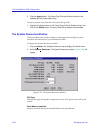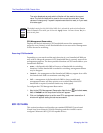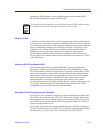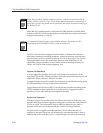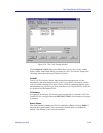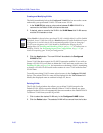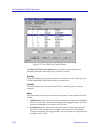
Managing the Hub 2-61
The SmartSwitch 2000 Chassis View
SmartSwitch 2000 Þrmware version 4.00.08 supports the pre-standard IEEE
802.1Q draft speciÞcation for port-based VLANs.
What is a VLAN?
A Virtual Local Area Network (VLAN) is a logical group of devices that function
as a single Local Area Network segment (broadcast domain). Devices comprising
a VLAN may be (physically) widely separated, allowing users located in separate
areas or connected to separate ports to belong to a single VLAN group. Users
assigned to a VLAN can send and receive broadcast and multicast trafÞc as
though they were all physically connected to a single network segment.
VLAN-capable switches isolate broadcast and multicast trafÞc received from
VLAN groups, and contain broadcasts and multicasts from members of a VLAN
within that group.
What is an 802.1Q Port-Based VLAN?
Switches that support the pre-standard IEEE 802.1Q draft speciÞcation for
port-based VLANs act by classifying frames into VLAN membership. Usually,
VLAN classiÞcation is based on tag headers (VLAN tags) in the headers of data
frames. The tag header is inserted into the frame directly after the Source MAC
address Þeld. A four-byte Þeld in the tag header is used as the VLAN identiÞer.
These VLAN tags are added to data frames by the switch as the frames are
transmitted and/or received by certain ports, and are later used to make
forwarding decisions by the switch and other 802.1Q switches. In the absence of a
VLAN tag, a frame is assigned VLAN membership according to the VLAN
conÞguration of the switch port that receives the frame.
About 802.1Q VLAN Configuration and Operation
An 802.1Q VLAN is deÞned by assigning it a unique identiÞcation number (the
VLAN ID) and an optional name. The VLAN ID is used to identify data frames
that originate from, and are intended for, the ports assigned to the VLAN. Up to
64 VLANs may be created, with VLAN IDs ranging from 2-4094. VLAN ID 1 is
reserved for the Default VLAN.
Ports on 802.1Q switches are assigned membership in a VLAN by associating a
VLAN ID with each port on the switch. The VLAN ID is combined with the portÕs
identiÞcation (e.g., device X port X) to form the Port VLAN ID (PVID).
NOTE
For SmartSwitch 2000 Þrmware versions 4.00.08 and above, HSIM-F6 modules cannot
be installed in a SmartSwitch 2000 that is operating in 802.1Q mode.



